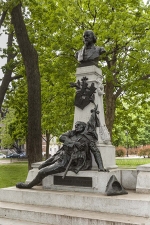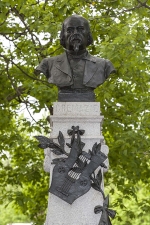Louis-Philippe Hébert
Monument à Louis-Octave Crémazie
1906
Presentation of the artwork
Composed in a triangular plane, the monument takes the form of a stele with a parapet at its foot and sits on a stepped pedestal; the entire monument is made of pale-grey granite. Atop the stele is the bust of Louis-Octave Crémazie, considered the first national poet, and on the front face below the bust is a lyre crossed by a laurel branch, the symbol of the poet’s inspiration. At the bottom of the pedestal is the figure of a soldier who has died in combat, clasping in his arms the flag of Carillon used by the French forces led by General Montcalm in the battle for Fort Carillon, in the state of New York, in 1758. The line “Pour mon drapeau je viens mourir ici” (For my flag, I have come to die here), on a plaque beneath the soldier, is taken from Crémazie’s poem Drapeau de Carillon, written for the centenary of this victory. On the back of the monument, a bronze plaque, installed just before the statue’s inauguration, reads, “Érigé par ses compatriotes du Canada et des États-Unis, inauguré le 24 juin 1906.” (Erected by his compatriots in Canada and the United States, inaugurated on 24 June 1906).The monument was inaugurated in 1906 in Saint-Louis Square, bordering Rue Saint-Denis, by Louis Fréchette, instigator of the project, before 30,000 people. In 1972, during an embellishment campaign, the executive committee authorized its move to Place Crémazie, at the corner of Crémazie and Saint-Laurent boulevards. The monument was moved back to Saint-Louis Square in 2002 and a series of steps was added.
Associated events
Louis-Octave Crémazie was born in Québec City on 16 April 1827. After studying literature at the Séminaire de Québec, he opened a bookstore, with his brother Joseph, that became the meeting-place for the cultural élite of Québec City. Crémazie began to publish poems in local newspapers in 1849; the ultimate accolade came in 1858, when his Drapeau de Carillon earned him the title of “national poet.” In 1862, he fled to France, to which he had often travelled in the 1850s; besieged by debt, he had produced false credit guarantees. In France, he lived under the name Jules Fontaine until his death on 16 April 1879, in Le Havre.
Louis-Philippe Hébert
Louis-Philippe Hébert (27 January 1850, Sainte-Sophie-d’Halifax, Québec – 13 June 1917, Westmount, Québec) received training in the Quebec tradition of sculpting in wood passed down from the eighteenth century. He quickly turned toward the complex techniques of bronze casting that he discovered during his frequent visits to Paris. An elegant and conscientious artist, Hébert was able to assimilate the essentials of this method. With his majestic artworks, he marked a fundamental step forward in the art of sculpting in Québec, which also brought the province across the threshold of modernity.
Awards and honours
- Chevalier de Saint-Michel et de Saint-Georges, 1903
- Chevalier de la Légion d'honneur, 1901
- Médaille de la Confédération, 1894
- membre de la Royal Canadian Academy of Arts, 1880
Presentation of the artwork
Composed in a triangular plane, the monument takes the form of a stele with a parapet at its foot and sits on a stepped pedestal; the entire monument is made of pale-grey granite. Atop the stele is the bust of Louis-Octave Crémazie, considered the first national poet, and on the front face below the bust is a lyre crossed by a laurel branch, the symbol of the poet’s inspiration. At the bottom of the pedestal is the figure of a soldier who has died in combat, clasping in his arms the flag of Carillon used by the French forces led by General Montcalm in the battle for Fort Carillon, in the state of New York, in 1758. The line “Pour mon drapeau je viens mourir ici” (For my flag, I have come to die here), on a plaque beneath the soldier, is taken from Crémazie’s poem Drapeau de Carillon, written for the centenary of this victory. On the back of the monument, a bronze plaque, installed just before the statue’s inauguration, reads, “Érigé par ses compatriotes du Canada et des États-Unis, inauguré le 24 juin 1906.” (Erected by his compatriots in Canada and the United States, inaugurated on 24 June 1906).The monument was inaugurated in 1906 in Saint-Louis Square, bordering Rue Saint-Denis, by Louis Fréchette, instigator of the project, before 30,000 people. In 1972, during an embellishment campaign, the executive committee authorized its move to Place Crémazie, at the corner of Crémazie and Saint-Laurent boulevards. The monument was moved back to Saint-Louis Square in 2002 and a series of steps was added.
Associated events
Louis-Octave Crémazie was born in Québec City on 16 April 1827. After studying literature at the Séminaire de Québec, he opened a bookstore, with his brother Joseph, that became the meeting-place for the cultural élite of Québec City. Crémazie began to publish poems in local newspapers in 1849; the ultimate accolade came in 1858, when his Drapeau de Carillon earned him the title of “national poet.” In 1862, he fled to France, to which he had often travelled in the 1850s; besieged by debt, he had produced false credit guarantees. In France, he lived under the name Jules Fontaine until his death on 16 April 1879, in Le Havre.
Louis-Philippe Hébert
Louis-Philippe Hébert (27 January 1850, Sainte-Sophie-d’Halifax, Québec – 13 June 1917, Westmount, Québec) received training in the Quebec tradition of sculpting in wood passed down from the eighteenth century. He quickly turned toward the complex techniques of bronze casting that he discovered during his frequent visits to Paris. An elegant and conscientious artist, Hébert was able to assimilate the essentials of this method. With his majestic artworks, he marked a fundamental step forward in the art of sculpting in Québec, which also brought the province across the threshold of modernity.
Awards and honours
- Chevalier de Saint-Michel et de Saint-Georges, 1903
- Chevalier de la Légion d'honneur, 1901
- Médaille de la Confédération, 1894
- membre de la Royal Canadian Academy of Arts, 1880






